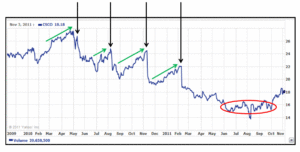Dexter and his friends are walking down the street. A group ahead sees something lying in the street. It’s a genuine Frisbee brand flying disc. Dexter watches as they take a quick look and walk past. When Dexter comes to it, he sees it’s dirty but otherwise in good shape. Yet, he walks past as well. Why did Dexter walk by the Frisbee?
This is the story of value stocks, companies that are being ignored by the vast majority of investors. Dexter probably walked by the Frisbee because he saw his buddies walk by it as well. No one wanted to be the person to pick it up. Corporations sometimes wind up being thrown in the gutter.
How, exactly does a corporation chase investors away? One way is to be associated with a stagnating or declining market. Even if the corporation is doing good things, if the market the corporation is operating in is not growing, over time investors may give up on it. This is the way many people feel about companies that make personal computers. Less of them are selling each year as consumers migrate to tablets and phones.
Another way to turn off investors is to have earnings “misses” quarter after quarter. The drop in the share price that can occur after an earnings miss can be demoralizing. Doing it again and again can cause investors to simply lose faith in the management of the corporation and give up by selling their shares. Below we see a great example in the huge networking equipment supplier Cisco Systems back in 2010:
Quarter after quarter investors bought Cisco’s stock, bidding it up before earnings (green arrows) in anticipation that it would get on track. Yet, time and again, Cisco disappointed investors (black arrows) and provided little indication it was getting a handle on its problems. The stock then plunged. Yet, being such as legendary corporation, Cisco enjoyed interest from new investors who figured they’d take their shot. Eventually, they gave up, too. The stock plummeted all the way down to about $16 and stayed there for four months (red oval). It was arguably a great value at that price.
| Suitable for | Investors who are extremely patient and insightful and who believe by purchasing the shares of good companies at low prices, they can take the downside risk out of their investments. Patience is required because it could take months to a year or more after an investor purchases a stock for the larger investment community to notice it is underpriced and begin sending it higher by purchasing it. | |
| Examples | LendingClub (LC), Natuzzi (NTZ) | |
| In the news | Value Managers Go on A Buyer’s Strike – November 07, 2013.
Jim Chanos On Hewlett-Packard: ‘The Ultimate Value Trap’ – July 18, 2012. With Earnings on the Way, Is Cisco Still a “Value” Stock? – August 14, 2012. 2 Value Stock Treats Amid Tricky Market – October 31, 2011. Microsoft Looks Cheap—as Usual – April 28, 2011. |
|
| Connections | If a corporation’s share price has dropped significantly but it has not cut its dividend, this can increase its dividend yield as high as those of income corporations. | |
| Explorations |
|
|
| A final word
|
The father of value investing is Benjamin Graham. In 1949 he wrote the book The Intelligent Investor, which defined value investing principles. The most famous value investor is Warren Buffett, who over 50 years built Berkshire Hathaway (BRKA) into a massive holding corporation which owns dozens of other corporations. Among the corporations Berkshire Hathaway owns entirely are GEICO, Dairy Queen, and Benjamin Moore paints. |


